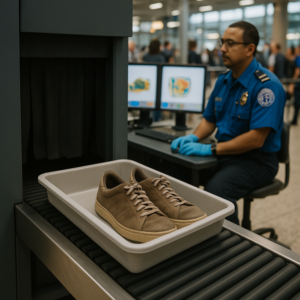No Shoes, No Problem: TSA Just Made Travel Less Annoying

You know that awkward shuffle in the TSA line? One shoe off, one hand juggling your laptop, and the ever-present fear of someone judging your sock choice? Well, good news: that part of the airport ritual might finally be over.
In a quiet but glorious move, TSA has rolled out a policy allowing most travelers to keep their shoes on during security screening. After 20 years of toe exposure, public lacing, and general travel indignity, it’s a welcome change.
Naturally, we were curious—how do travelers really feel about this? So we ran a quick nationwide survey using Pollfish to find out. And yes, American travelers have thoughts.
“Wait—this is real?”
First, the awareness check. While, sixty percent of people were already in the know. The shock factor was real – with 84% surprised with the news.
One respondent said, “I thought I misheard it on the news—like, surely I’m not going to be able to walk through with my shoes on?”
You are. And if you’re still skeptical, we get it. After two decades of taking off our footwear like we’re entering a traditional tatami room, it feels… weird. But in the best way.
The People Have Spoken: Feet First, Worries Later
Once people got over the initial shock, the mood shifted quickly to celebration. According to the Pollfish survey:
- Over half of travelers (57%) said they feel positive about the change.
- Just 13% had anything remotely negative to say.
- And the rest? Probably still recovering from past foot-related trauma.
There’s something universally comforting about not having to expose your socks to public scrutiny before 8 a.m.
The Real Perks? They’re Not Just About Comfort
Sure, convenience matters (and 51% of people said it’s their top reason for loving the change), but the benefits run deeper—literally:
- 70% said faster lines were the biggest win.
- 40% cited hygiene (yes, because airport carpet is not your friend).
- And 37% said it actually reduced stress, which is saying something, because air travel has a black belt in raising cortisol.
It’s not just about comfort—it’s about efficiency, dignity, and reclaiming one small corner of your autonomy in the chaos of modern travel.
So… Does This Make Security Less Safe?
A fair question—and one many travelers still asked.
Interestingly, only 9% said they feel less confident in airport security because of the change. The majority—62%—feel just the same, and nearly 30% said they feel more confident, likely thanks to updated technology behind the scenes (think better scanners, not looser rules).
The vibe: “If you trust your tech, we’ll trust your process.” Mostly.
But What About TSA PreCheck?
Ah yes, the elephant in the express lane.
For years, TSA PreCheck has been the promised land for frequent flyers—shorter lines, fewer hassles, and yes, shoes stayed on. But now that everyone gets to skip the footwear removal?
- 15% say PreCheck feels less valuable
- 36% say it’s “somewhat” less enticing
- Still, 76% would enroll or renew anyway
Why? Because PreCheck isn’t just about shoes—it’s about not removing belts, laptops, or dignity, and generally getting to feel like a VIP in Zone 3.
Final Boarding Call: This Change Matters
It’s easy to roll your eyes at something like “no more shoe removal” being treated as a major win. But it is.
Because this tiny change represents something bigger. A system that’s learning, adapting, and—dare we say—humanizing travel just a bit.
So next time you’re at security and realize you can walk straight through in your boots, loafers, or Crocs (we’re not judging), give a little nod of appreciation. To progress. To convenience. To TSA’s long-overdue footwear liberation.
And maybe—just maybe—pack better socks. Just in case.
Bonus: We Got These Insights in Under 30 Minutes
Like the new security lines, collecting this data was quick and painless. Using the Pollfish platform, we surveyed 100 U.S. travelers in less than 30 minutes—no lines, no waiting, and no unlacing required.
So if you’re wondering what your audience thinks, just ask them. Quickly, easily, and in real time.
b2bmarketing@prodege.com
Ready to Try Pollfish?
Create your survey with AI, target high-quality respondents starting at $0.95 per complete, and start getting results in just minutes in real-time. From running a simple product concept survey to managing a constant stream of trackers for dozens of clients in dozens of countries, we’ve got you.
